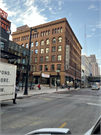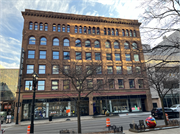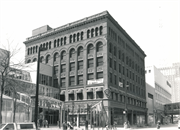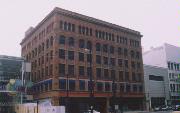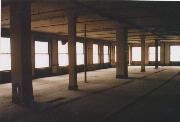Property Record
301 W WISCONSIN AVE
Architecture and History Inventory
| Historic Name: | MATTHEWS BROS. BUILDING |
|---|---|
| Other Name: | WOOLWORTH BUILDING |
| Contributing: | Yes |
| Reference Number: | 16177 |
| Location (Address): | 301 W WISCONSIN AVE |
|---|---|
| County: | Milwaukee |
| City: | Milwaukee |
| Township/Village: | |
| Unincorporated Community: | |
| Town: | |
| Range: | |
| Direction: | |
| Section: | |
| Quarter Section: | |
| Quarter/Quarter Section: |
| Year Built: | 1892 |
|---|---|
| Additions: | |
| Survey Date: | 1984 |
| Historic Use: | large retail building |
| Architectural Style: | Romanesque Revival |
| Structural System: | |
| Wall Material: | Brick |
| Architect: | George B. Ferry And Alfred C. Clas |
| Other Buildings On Site: | |
| Demolished?: | No |
| Demolished Date: |
| National/State Register Listing Name: | West Side Commercial Historic District |
|---|---|
| National Register Listing Date: | 12/22/2000 |
| National Register Multiple Property Name: |
| Additional Information: | A 'site file' exists for this property. It contains additional information such as correspondence, newspaper clippings, or historical information. It is a public record and may be viewed in person at the Wisconsin Historical Society, Division of Historic Preservation. Another map code is 19/22, found on the LUQS #392 Map. DESCRIPTION: The Matthews Building was constructed beginning in 1893 at the cost of $100,000 by the prominent Milwaukee firm of Ferry and Clas. Built as speculative offices by the Matthews brothers, owners of a Milwaukee furniture manufactory, the six story building was designed in the Renaissance Revival style and executed in a buff brick with terra-cotta trim. Although the first two stories have been obliterated by alterations, the remaining facades are divided into five major bays through piers on the third (3rd) floor and extending to the fifth (5th) floor, where they terminate in a blind arcade. The piers are alternately capped with a Corinthian motif and that of a simple profile. Each of these bays is further emphasized by a single story arcade on the sixth (6th) floor, consisting of smaller arches that continue, yet diminish, the rhythm established on the lower floors. The sixth floor is completed by a strong cornice, and the entire building is terminated by a parapet wall. Despite the absence of the original first and second floor facades, the hierarchical division of the entire facade through piers and arcades creates the impression of an orderly distribution of loads, from the upper stories to ground level. The effect is similar to, yet lacking the subtlety of, H.H. Richardson's Marshall Field Wholesale Store, built in Chicago in 1885. The verticality set up by the piers and arcade is countered by molded terra-cotta spandrels, located between the third and fourth and fifth floors. These are richly decorated with raised floral motifs and cherubs. The fifth and sixth stories are separated by brick work bounded by the arcade below and a terra-cotta cornice above, which acts as a sill for the sixth floor windows. The windows on the third and fourth floors are a double-hung configuration constructed in wood with a one-over-one light arrangement. These windows have terra-cotta head, jambs, and sills, the latter two with an egg and dart molding. The fifth floor windows are similar except for the round heads, which are framed by a drip of molded terra-cotta. The windows on the sixth floor are smaller and more deeply set into the wall than those on other floors. Each bay contains four windows except the central bay which has six. Each opening is defined by small pilasters sheathed with terra-cotta and capped with a small Corinthian capital which acts as an impost for the round-arched window head. The windows themselves are wood frame, 1/1 double-hung with a fixed light within the arched head. Became the Woolworth Building in 1935. Renovated in 1981. Alterations to the fabric have occurred as follows: Permit #17072, September 16, 1936, records the construction of a three story plus basement steel frame addition to the south facade of the original building. The architects were Kirchoff and Rose. The major and most harmful alteration of the original building consists of the application of porcelain enamel panels to the original first and second floor facades. SIGNIFICANCE: The Matthew's Building was apparently built as a speculative venture by brothers Eschines P. (1832-1913) and Alonzo R. (1835-1901) Matthews. Natives of Ohio, the Matthews brothers came to Milwaukee in 1856, and soon after established a furniture shop on East Water Street. Eventually the Matthews Brother's Furniture Factory was formed, remaining under their direction until they retired in 1890. The brothers held control of the factory until Eschine's death in 1913. The building itself remained in the family until the mid-1920's. The architects, Ferry and Clas, were in partnership between 1890 and 1912. During that period they contributed may fine residential, commercial and public buildings to Milwaukee. These include the Public Library and Museum (1895-1899), the Steinmeyer Building (1893-1894), Northwestern National Insurance Company (1907), the Frederick Pabst mansion (1892), and the First Unitarian Church (1891-92). Alfred C. Clas (1859-1936) was born in Sauk City, Wisconsin and received his architectural training through apprenticeships, both in Wisconsin and Caifornia (1879-1881). Upon his return to Milwaukee, he worked in the office of James Douglas, and by 1890, he had entered into partnership with George B. Ferry. After their association ended in 1912, Clas worked with his son, Angelo, until 1920 and in other partnerships until his death in 1936. George Bowman Ferry (1851-1918) was born in Springfield, Massachusetts and received his education in architecture at the Massachusetts Institute of Technology, graduating in 1872. He came to Milwaukee in 1881 and by 1890, was in partnership with Clas. |
|---|---|
| Bibliographic References: | BUILT IN MILWAUKEE, LANDSCAPE RESEARCH, P. 83. Milwaukee Business Journal 10/3/2003. MILWAUKEE HISTORIC BUILDINGS TOUR: KILBOURNTOWN, CITY OF MILWAUKEE DEPARTMENT OF CITY DEVELOPMENT, 1994. The Milwaukee Business Journal, 3/28/1997. National Register of Historic Places form. Building Permints and other records, 1893-1978, General Office, Department of Building Inspection and Safety Engineering Gregory, J.G., HISTORY OF MILWAUKEE, vol. 111, 88-89, 188-192. Latus, Mark A. and Mary Ellen Young. DOWNTOWN MILWAUKEE. (Milwaukee American Revolution Bicentennial Commission). 1978. MILWAUKEE CITY DIRECTORIES, 1901-1930. Perrin, Richard W.E., MILWAUKEE LANDMARKS, Milwaukee, 1968. 81-87. WISCONSIN NECROLOGY, vol. 16, 167-168. |
| Wisconsin Architecture and History Inventory, State Historic Preservation Office, Wisconsin Historical Society, Madison, Wisconsin |

